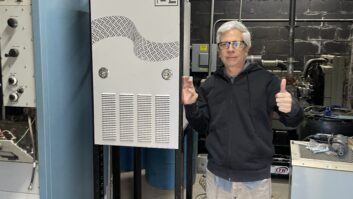A “Cold War Warrior” rests in a watery grave beneath the serene Caribbean, with nothing to mark its final resting place.
During the Cold War, Radio Free Europe, with transmitters in Germany and Portugal, concentrated its broadcasts on the populations of Poland, Hungary, Czechoslovakia, Bulgaria and Romania. Radio Liberty broadcast to the Soviet Union in Russian and its many languages.
Although many listeners in those countries had radios with shortwave capability, others owned less-expensive sets that received only medium waves, what we call AM in the United States.
Therein lay a problem. Ideal shortwave transmitter sites were sufficiently far from their targets that signals could be bounced off the ionosphere. Medium-wave transmissions, particularly during daylight hours, rely on ground waves, so their coverage distance is limited. If you want to reach a population of medium-wave listeners, the transmitters should be closer to the target and as powerful as possible.
One of RFE’s most important targets, Czechoslovakia, was next door to Germany.So why was its main medium-wave transmitter, broadcasting in the Czech language, placed in Holzkirchen near Munich, some 200 miles from Prague, the Czech capital city?
The Czech desk was proud of its facility, located against a backdrop of the Bavarian Alps, with the four towers of its directional antenna array tall and proud against the sky – lovely to look at, a great place to take visitors, so easy to reach from Munich.
But its signals did not reach the target well, as RFE engineers found when they took field-strength readings on the German-Czech border. Jamming was so intense that the signals were barely audible.
Something had to be done to fix that.
Portable radio
In the early 1950s, I was engineer-in-charge of the RFE Receiving and Monitoring station, built on an old fighter airbase in the town of Schleissheim, near Munich.
One day, a group of seven 40-foot trailers arrived and parked on the abandoned runway. The trailers comprised a cooling blower van, a studio van, a high-frequency receiver van, a shop van, a power supply van, a diesel tanker and an RCA 50 kW medium-wave transmitter. The MB-50 contained a complete station in those trailers; it lacked only an antenna.
We were told only that this was to be known as the MB-50, for Medium-Wave Broadcast, 50 kW; that it had been ordered by some unmentioned U.S. government agency for a lot of money; and that it had been built by engineer Ben Adler of Mamaroneck, N.Y.
We were told that it would stay there until further notice, ready to go, watched over by our guards. “Ours not to question why.” We kept it guarded and dusted, and we waited for something to happen.
The MB-50 sat for more than a year. Then we learned that it was to be moved up to the little Bavarian town of Cham, about six miles from the Czech border.
We visited the location. The site had been cleared; a two-tower parasitic antenna array, designed by the chief projects engineer, the late Ken Owen, had been erected.
Close to the border? Indeed. With binoculars I could see border towers, with a guard staring back at me through his binoculars.
The MB-50 vans were hauled up to the town of Cham, positioned on the site and checked out. A good operating frequency was selected in the middle of the broadcast band and the transmitter was fired up. Everything worked fine. The German telephone company Deutsche Post was contacted, and a program line and “order wire” were established connecting the Czech studios at RFE in Munich to the transmitter site.
Short service
After the MB-50 went on the air, our mail pull from Czechoslovakia increased dramatically, proving that the site was delivering a good signal despite jamming.
Operation at Cham became routine for several months, until orders came to close down the site and prepare the MB-50 for travel to the port of Bremerhaven.
Another case of “ours not to question why.” I was given a Jeep and put in charge of leading the MB-50 convoy up to the port of Bremerhaven, about a 400-mile trip.
Everything went well until we reached the edge of the city of Bremen. I had instructed the drivers to assemble and wait for me to lead them through the town. How I was going to do this, I didn’t know; I had never been to Bremen.
When I arrived at the rendezvous point, only two of the vans were present. Where were the others? A friendly German policeman drove up in his big BMW and asked in excellent English, “Got a problem?” After listening to my explanation he said, “Don’t move. I’ll round up the rest of the convoy and bring it here. Then you all follow me through the town and I’ll put you on the road to Bremerhaven.”
So with the help of the local police, the U.S. government’s latest Cold War weapon arrived at the port. We contacted the RFE shipping agent and parked the MB-50 in a designated spot, to be used for purposes unknown. The drivers spent the night and returned to Munich by train.
I drove on to the town of Höchst, near Frankfurt, to the headquarters of the Armed Forces Network; I was to borrow its puny 5 kW mobile transmitter to replace the MB-50 in Cham. Not too fair a swap for the powerful MB-50 – unlikely to make much of a dent in the jamming.
Fate of the MB-50
Months passed and we heard nothing about the MB-50 until we received a report that vandals had broken into it at the port and stolen the transformers for the copper. Eventually it was repaired and shipped out to “somewhere.”
Not until a few years later did I learn that “somewhere” was Swan Island, a tiny, uninhabited piece of real estate in the Caribbean. The CIA used the MB-50 to broadcast to Cuba during the Bay of Pigs fiasco.
It stayed there for a while, transmitting programs despite intense jamming.
The ultimate fate of the MB-50 remained unclear to me until I met an engineer who had worked with it in the Caribbean. I asked him what became of the equipment. He claimed that they had “deep-sixed” it – shoved it off the end of the dock.
This is an ignoble fate for a great transmitter that performed yeoman service broadcasting programs, first in the Czech language, and then in Spanish, to counter Communist propaganda.
Now, its tasks accomplished, it rests in a watery grave beneath the serene Caribbean, with nothing to mark its final resting place.












